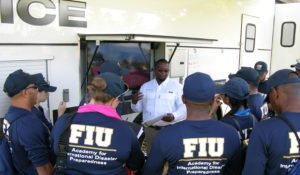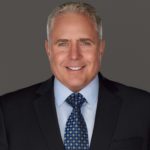 Breaking Down Barriers: Increasing Diversity and Inclusion in the Drone and Robotic Vehicles Industry
Breaking Down Barriers: Increasing Diversity and Inclusion in the Drone and Robotic Vehicles Industry
AUVSI Florida Peninsula Chapter considers diversity and inclusion, and takes a strategic and actionable approach to creating more opportunities in the drone industry for everyone.
The following is a guest post by Christopher Todd, President of the AUVSI Florida Peninsula Chapter and the Executive Director of AIRT, Inc., the nation’s leading 501(c)3 non-profit organization supporting drones for emergency use and official home of DRONERESPONDERS. DRONELIFE neither accepts nor makes payment for guest posts.
AUVSI Florida takes action to increase opportunities in the drone industry for everyone on the cusp of Black History Month
Living in Miami for the past quarter-century has certainly impacted my perceptions surrounding many things – sometimes for better, and sometimes for worse. But perhaps the greatest and most undeniable fact is that South Florida has one of the most diverse populations you will find anywhere in the United States, if not the world.
By many accounts, as a single white male I am a minority living in Miami-Dade County. When I first moved here, I was scolded by the Cuban women working at the deli counter of the local grocery store because I was not speaking to them in Spanish.
“You live in Miami, and you don’t speak Spanish?” they asked me.
“Si,” I replied.
We all laughed.
Yes, I know. You have probably watched the movie Scarface, seen news reports, and you understand that Miami has an immense Cuban population. But this goes way beyond that.
The Paelo-Indians arrived in what is now Florida more than 12,000 years ago. Around 500 BC, these people, commonly referred to as the Calussa, or “fierce people,” began to devolve into more distinct regional cultures and spread out across Florida.
Then came the Spanish.
In 1565 the Spanish arrived in Florida and founded St. Augustine, the oldest continually habituated city in what is now the United States. The city came under British control in 1763, before being ceded back to Spain in 1783, and then eventually ceded to the United States in 1821.200 years later, we have modern-day Florida with diverse populations throughout the state, especially in the key population centers of Miami, Orlando, and Tampa. And South Florida, the area comprised of Miami-Dade, Broward, and Palm Beach Counties, is a region is filled with expats and migrants from just about every country in the world.
South Florida boasts heavy international influences, especially those of Caribbean and South American immigrants, combined with the descendants of Anglo, Spanish, Afro-Caribbean, and Latino populations. There is a large LGBT community established in the region. The result is an eclectic and robust cornucopia of diverse languages, cultures, traditions, genders, and lifestyles that make South Florida a fascinating place to live or visit.
And it is because of all this fascinating culture that it becomes very easy for me to forget what life is like in many other regions of the U.S.
I grew up in a small, rural town in Southeastern Wisconsin. A region that was heavily populated by the descendants from Northern European cultures – especially Germany and Scandinavia. There were about 400 people in my high school graduating class. One of my classmates was black, and maybe another one had a Spanish last name.
So yeah, not a lot of diversity back in those days in terms of culture and ethnicity. But that was also just evolution in progress. It was how the world was at that point and place in time.
Today, when I visit rural Wisconsin, I see a much more diverse population mix than existed there 30 years before. And there is not surprising as industry and manufacturing has moved from the big cities to the rural areas where land costs less.
When one looks at the migration paths of cultures and populations over the course of history, key moments mixed with opportunity and commerce – like the gold rush and building the railroads – have largely dictated when, where, and how people have relocated. When these relocations happen, a typical outcome has been that different populations and ethnicities intermix, resulting in more diverse population centers eventually leading to more inclusive opportunities across all facets of life.
So that begs the question of how we increase diversity and inclusiveness in an uncrewed systems industry historically dominated by white males when advances in remote working capabilities and other technology now eliminate the need for people to congregate in specific geographic areas to live and work with one another?
“There are no easy answers to that question,” says Eric Schwartz, Vice President, Florida Peninsula Chapter of AUVSI (AUVSI Florida). “Finding a viable solution starts with identifying and accepting the fact that diversity really is a legitimate issue that needs to be addressed. In Florida, I feel that we have already crossed the Rubicon.”
Taking Action to Create Opportunities in the Drone Industry
The specific course of action that Schwartz is referring to is the decision the AUVSI Florida Board of Directors made at its January 2022 membership meeting to establish a Diversity and Inclusion Committee to help foster increased opportunities in the drone industry for people of all genders, ethnicities, cultures, and lifestyles to take an active role in drone and uncrewed vehicle systems sector.
The board voted unanimously to take that action, and appointed Lorean “Ty” Rozier, a respected Florida entrepreneur, remote pilot, U.S. Army veteran, and AUVSI Florida member to lead that effort as committee chairperson.
“It is an honor to take on this new responsibility and lead the strategy for expanding inclusivity surrounding the work of the Florida Peninsula Chapter of AUVSI,” said Rozier. “We’ll look to break down traditional barriers while welcoming participants across all cultures, genders, creeds, and lifestyles to engage one another in the realm of uncrewed and remotely piloted vehicle systems.”
Rozier says while specific initiatives to increase diversity will be announced in the coming months, the first priority will be to initiate communications that expand awareness about the benefits of having a more diverse and inclusive ecosystem – both within AUVSI Florida and across the entire industry.
“Putting people in the same room together – whether virtually or in-person – goes a long way towards breaking down barriers and opening up new avenues of opportunity among all participants,” says Rozier. “It all starts with communication.”
Schwartz completely agrees.
“This is about far more than corporate responsibility initiatives and public relations campaigns,” says Schwartz. “It is about increasing dialogue and stimulating conversations with groups of people who have not been historically connected to our industry. We are seeking to create measurable change by welcoming new participants into the AUVSI Florida family. Ultimately, that will help increase awareness and drive the growth and adoption surrounding uncrewed vehicle systems that we all want to see.”
And that really the crux of the matter – the other half of the issue that most subject matter experts fail to address when talking about the need for increased diversity and inclusion. Not only is it proper and just from an ethical perspective, but it also makes good business sense.
“I think this is the part of the argument that a lot of folks either ignore, or are just afraid to talk about,” says Rozier. “There are solid economic arguments as to how an increase in diversity within a business sector leads to an increase in market penetration and size. Look at how U.S. companies are hiring Chinese-Americans to help forge new relationships and sell American products in China.”
With larger market sizes come more opportunities to generate revenue. With larger labor pools of workers possessing with more advanced science, technology, engineering, and math (STEM) skill sets, comes lower employment costs for manufacturers, integrators, solution providers, and end users. The result will be a stronger, more cohesive drone and robotics industry.
Assimilating new voices into the conversation will also serve to increase awareness and adoption surrounding uncrewed vehicle systems – something the industry desperately needs as drones increasingly take to the National Airspace System (NAS), more autonomous trucks travel down our highways, and Advance Air Mobility (AAM) starts to become a reality.
As we embark upon Black History Month 2022 and hear calls for increased action leading to more opportunities in the drone industry for minority groups and underserved communities, pay attention and listen with an open mind. Look through the politics and study at the facts. Increasing diversity and inclusion in the drone and uncrewed vehicle systems industry is not only the right thing to do, but it will be good for business.
Read more from Chris Todd and the AUVSI Florida Peninsula Chapter.
 Christopher Todd is the President of the AUVSI Florida Peninsula Chapter and the Executive Director of AIRT, Inc., the nation’s leading 501(c)3 non-profit organization supporting drones for emergency use and official home of DRONERESPONDERS – the world’s fasted growing program advancing public safety use of unmanned aircraft systems (UAS). Chris is a Certified Emergency Manager (CEM®) and FAA-certified Remote Pilot, who also works as an entrepreneur and consultant having helped grow billion-dollar companies in the technology industry.
Christopher Todd is the President of the AUVSI Florida Peninsula Chapter and the Executive Director of AIRT, Inc., the nation’s leading 501(c)3 non-profit organization supporting drones for emergency use and official home of DRONERESPONDERS – the world’s fasted growing program advancing public safety use of unmanned aircraft systems (UAS). Chris is a Certified Emergency Manager (CEM®) and FAA-certified Remote Pilot, who also works as an entrepreneur and consultant having helped grow billion-dollar companies in the technology industry.
Miriam McNabb is the Editor-in-Chief of DRONELIFE and CEO of JobForDrones, a professional drone services marketplace, and a fascinated observer of the emerging drone industry and the regulatory environment for drones. Miriam has penned over 3,000 articles focused on the commercial drone space and is an international speaker and recognized figure in the industry. Miriam has a degree from the University of Chicago and over 20 years of experience in high tech sales and marketing for new technologies.
For drone industry consulting or writing, Email Miriam.
TWITTER:@spaldingbarker
Subscribe to DroneLife here.
https://dronelife.com/2022/02/01/increasing-opportunities-in-the-drone-industry-auvsi-florida-is-taking-action/
 Unmanned Aerial Vehicle The latest drone news
Unmanned Aerial Vehicle The latest drone news



